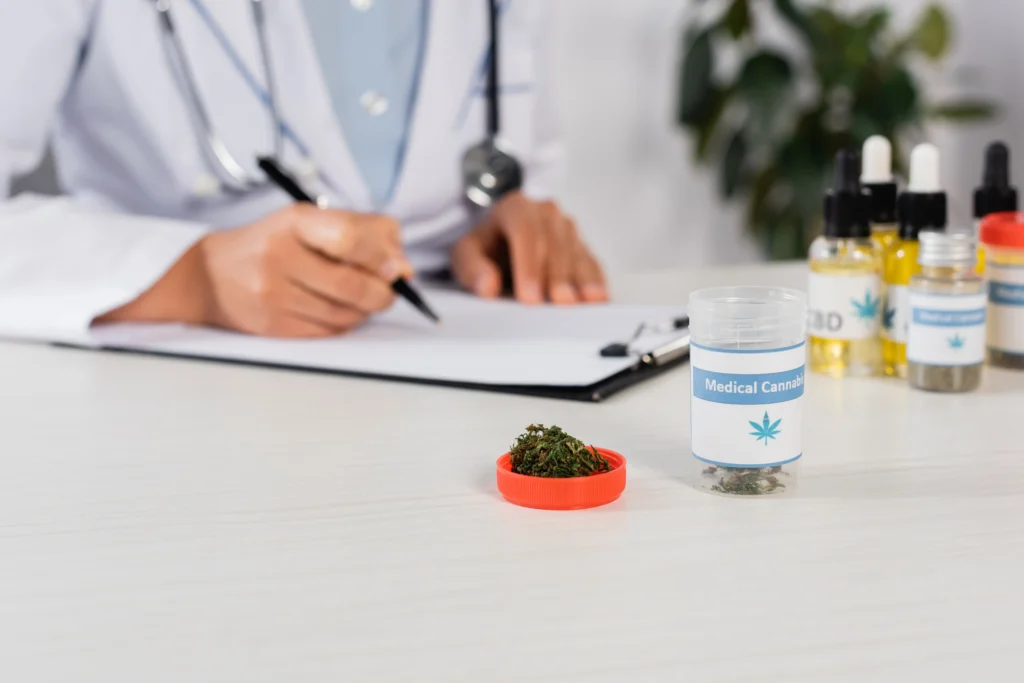
Table of Contents
ToggleMedical marijuana, also known as medicinal cannabis, refers to the use of cannabis plants or their active components—tetrahydrocannabinol (THC) and cannabidiol (CBD)—to treat specific medical conditions. Unlike recreational marijuana, which is often high in THC for psychoactive effects, medical marijuana is designed to maximize therapeutic benefits with a controlled THC-to-CBD ratio.
These compounds interact with the body’s endocannabinoid system to regulate pain, inflammation, and other critical functions. As a spine surgeon with over 25 years of experience treating patients in Long Island, I’ve seen how chronic pain conditions can deeply impact quality of life.
Medical marijuana for pain management has emerged as a promising alternative for individuals seeking relief from pain without relying solely on traditional methods like opioids. This innovative approach is rooted in science, offering real benefits for specific pain conditions while requiring careful consideration of its limitations.

The pain-relieving effects of medical marijuana lie in its interaction with the endocannabinoid system, a complex network of receptors throughout the body. Two key receptor types, CB1 and CB2, play distinct roles.
CB1 receptors are primarily located in the brain and spinal cord, where they influence pain perception. CB2 receptors, on the other hand, are found in immune cells and help reduce inflammation.
THC binds partially to both CB1 and CB2 receptors, modulating pain signals and reducing their intensity. CBD acts differently; it’s a negative allosteric modulator of CB1 receptors and interacts with serotonin and vanilloid receptors to mitigate pain and inflammation without causing a “high.”
This dual action helps address chronic pain from various angles, making medical marijuana effective for conditions like neuropathic pain and arthritis. For example, patients with nerve damage or sciatica—both common among those I treat at Long Island Neuroscience Specialists—often report significant relief after incorporating medical marijuana into their treatment plans.
By reducing inflammation and altering pain pathways, medical marijuana provides an innovative solution that complements physical therapy and other interventions.
Medical marijuana is not a universal solution for all types of pain. Its efficacy depends on the underlying cause and nature of the pain. Here are the primary conditions it addresses:
By tailoring treatment to the individual, we can maximize the therapeutic effects while minimizing risks. This patient-centric approach is critical at our practice.
Medical marijuana for pain management offers several compelling benefits. From my clinical experience, here’s what stands out:
Despite these benefits, medical marijuana is not a one-size-fits-all solution. It’s essential to evaluate whether it’s the right choice for each patient, considering factors like existing medical conditions and medication interactions.

While generally well-tolerated, medical marijuana is not without risks. Common side effects include:
Patients with psychiatric conditions like schizophrenia or bipolar disorder should exercise caution, as THC may exacerbate symptoms. At Long Island Neuroscience Specialists, we thoroughly review each patient’s medical history before recommending medical marijuana. Read more here.
Finding the right dosage is as much an art as it is a science. Based on the consensus from recent studies, we often start with CBD-predominant formulations due to their safety profile.
Here are key considerations:
At our practice, we emphasize patient education, ensuring they understand how to use medical marijuana safely and effectively.
Navigating the legal landscape of medical marijuana can be daunting. In New York, patients must meet specific criteria and obtain certification from a registered practitioner.
Here are key points:
Understanding these nuances helps patients access treatment while staying compliant with state and federal regulations.

While medical marijuana is a valuable tool, it’s not the only option for managing pain. Here are some alternatives:
Each patient’s pain management plan should be personalized, incorporating a mix of treatments tailored to their specific needs. Read more here.
Choosing the right dispensary is critical for ensuring the safety and efficacy of medical marijuana. Here’s what to look for:
By educating patients on these factors, we help them make informed decisions about their care.
GET IN TOUCH +
285 Sills Road
Building 5-6, Suite E
East Patchogue, NY 11772
(631) 475-5511
184 N. Belle Mead Road
East Setauket, NY 11733
(631) 675-6226
GET IN TOUCH +
285 Sills Road
Building 5-6, Suite E
East Patchogue, NY 11772
(631) 475-5511
184 N. Belle Mead Road
East Setauket, NY 11733
(631) 675-6226
SUBSCRIBE TO OUR NEWSLETTER +
Send us a Google review. Click this link and let us know how we did!
Review us on Yelp too.